Serenading the sublime souls of the soil

The Liberation War of Bangladesh is a glorious part of our history. People from all walks of life took part in the war and millions laid down their lives to free the motherland from the Pakistanis. Every year, the nation remembers the sublime sons of this soil with due respect and love. Our independence was hard-earned through a series of magnificent movements starting from the 1952 Language Movement to the 1971 Liberation War. The active participation of so many patriotic and creative persons including artists, sculptors, writers, journalists, filmmakers, singers and playwrights in all the glorious movements, contributed much to the creation of Bangladesh and the subsequent enrichment of its art, literature and culture.
The contributions of the country’s visual artists and sculptors to the War of Liberation are immense. Eminent artists Shilpacharya Zainul Abedin, Patua Quamrul Hassan, Nitun Kundu, Swapan Chowdhury, Rafiqun Nabi, Hashem Khan, Shahabuddin Ahmed, Debdas Chakraborty, Nasir Biswas, Pranesh Mandal and Biren Shome, among others, have portrayed the Liberation War in their distinctive styles. Their artworks played a pivotal role in inspiring the Bangalee people. The posters, festoons and banners painted by these artists motivated our people to raise their voice against the oppressive Pakistani rulers. They had painted many posters during every single important movement in the 60s. And every sketch, every poster or painting became as lethal as explosives to the Pakistani rulers. As a result, the Pakistani army raided the then Dacca Art College (Now Faculty of Fine Arts, University of Dhaka) and other parts of Dhaka city on March 25, 1971. Later some of the artists went to Kolkata to save themselves and started working for the sake of a sovereign Bangladesh.
On March 26, 1971, some of the artists took part in a procession carrying pro-liberation placards in their hands under the leadership of Shilpachaya Zainul Abedin and Poet Begum Sufia Kamal under the banner of “Charu O Karu Shilpi Sangram Parishad”. In that procession, they were carrying cartoons, caricatures, slogans and posters drawn by Quamrul Hassan, Qayyum Chowdhury, Rafiqun Nabi, Hashem Khan and others.

During the Liberation War, a team of artists tried to draw the attention of the rest of the world by sketching monograms of independent Bangladesh, stamps, posters, banners, cartoons and leaflets, as instructed by the provisional government’s Ministry of Information and Publicity, under the leadership of Quamrul Hassan. Besides, Mustafa Monwar, Swapan Chowdhury, Golam Mowla and others visited different camps and participated in different programmes to inspire the freedom loving people.
Shilpacharya Zainul Abedin was inside the country during the Liberation War. He saved his life by hiding himself on December 14, 1971, when the Pakistani army went on a horrifying killing spree of Bangalee intellectuals. Though in serious danger, he continued his fight using his own weapons: brush and colour. His painting titled ‘Soronarthi’ depicted the plight of the refugees crossing the border to save themselves from the genocide. ‘Muktijuddho’, a sketch that inspired many brave warriors, shows a team of Freedom Fighters going forward, their stance one of confidence and fearlessness. He has used a black brush in this sketch symbolising grief and hatred for oppressors. Abedin’s solidarity with the Muktijoddhas (Freedom Fighters) was evident in his refusal of a title given by Pakistani government to express his solidarity with the Freedom Fighters.
Quamrul Hassan’s most famous contribution to the Liberation War was the iconic caricature of Yahya Khan with the tagline ‘Annihilate these Demons’ which he did during the Pakistani army’s atrocities. The caricature was placed in front of Shaheed Minar for showing.
There were many other artists who played important roles during the War of Liberation. Preeminent artist Aminul Islam’s oil-painting ‘Gonohotya’, portrays hundreds of martyrs to illustrate the brutality of the Pakistani army. Moreover, a number of sketches by eminent artist Mustafa Monwar for the novel ‘Jahannam Hote Biday’ by Shawkat Osman were very impressive. In the canvas, he depicted Pakistani army’s war crimes – the genocide and rape they unleashed on the people.
The socio-political turmoil of pre-Liberation War times has been captured in the work of eminent artist Murtaja Baseer, a Language Movement veteran, who created the series ‘Wings of Butterfly.’
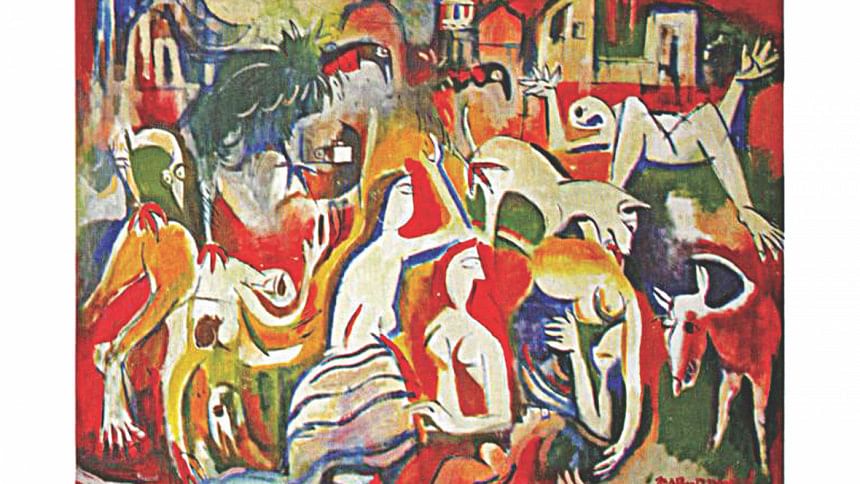
“I also created another series titled ‘The Wall’ in 1969. It portrays the ambience of suffocation that engulfed us all”, said Murtasa Baseer. “During the War of Liberation, I, along with my wife and our two daughters, fled to Paris. When I watched the plight of the Freedom Fighters and common people on television, I was driven by a deep sense of guilt. Then I created the ‘Epitaph for the Martyrs’ series as my homage to the Freedom Fighters,”
Renowned artist Qayyum Chowdhury also did a huge number of paintings on our Liberation War. Many of these were sketched during the war. Rafiqun Nabi, a young painter at that time, was confined during the entire war. From his first-hand experience he drew an image named ‘Bijoy’. He used the figure of an elephant to glorify the significance of freedom.
Another young painter of that time was Swapan Chowdhury, who displayed more than 200 paintings and drawings on the Liberation War during those days in Kolkata and other camps. His book ‘Ekattorer Chitroguchchho’ features those treasured drawings and paintings. He was a member of ‘Mukti Sangrami Shilpi Sangstha’ that kept up the morale of the Freedom Fighters in different camps by performing songs and poems. Late filmmaker Tareque Masud and his wife Catherine Masud later made a documentary film titled ‘Muktir Gaan’ (The Song of Freedom) in 1995 that explores the impact of cultural identity on the Bangladesh Liberation War in 1971, where music and song provided a source of inspiration to the Freedom Fighters and a spiritual bond for the whole emerging nation. American filmmaker Lear Levin did the cinematography of the film. Qayyum Chowdhury devoted his time to making posters and took an active part in demonstrations after the March 1971 crackdown by the Pakistan Army. Not only was his own life in danger for his active participation in the freedom movement but that of his family and friends too. Qayyum Chowdhury worked feverishly, motivated by his emotion and mind, drawing inspiration from what he saw before his eyes. At first bitter and full of angst, in 1971, with independence in hand for the nation that had suffered from one of the worst genocides in recorded history, Qayyum then brought in the portrayal of war with joyous victory in mind. His paintings and sketches then were like Delacroix’s Victory in theme and Goya’s other remarkable pieces on burning images of war. In his works, with the theme of Liberation War, one finds dancing lyrical lines, colours of protest, agony and suffering. The furious energy, the determination and dedication of the freedom fighters were perhaps not delineated better except by Hashem Khan or Shahabuddin Ahmed on canvas, much later on.
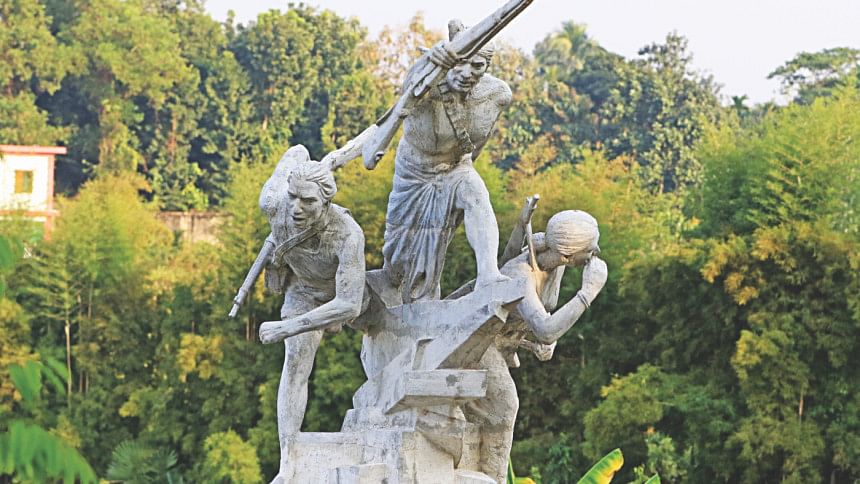
A freedom fighter, Hashem Khan was wounded in the 1971 war. He witnessed many painful incidents on the battlefield. ‘The Revolt of Bengal’, ‘The Speech of March 7’, ‘The River of ‘71’ and ‘The Letter of ’71’ are some of his painting series on this theme. The series delve into a nation’s longing for freedom. Animated male and female figures are visible in the works.
Apart from individual attempts, a group of artists who were living in Kolkata during the liberation war arranged an exhibition titled ‘Paintings and Drawings of Bangladeshi Artist’ at ‘Birla Academy’, Kolkata, in September 1971. This exhibition, showcasing 66 paintings by 17 artists, was important. The entire world came to know about the carnage launched by Pakistani Army through that exhibition.
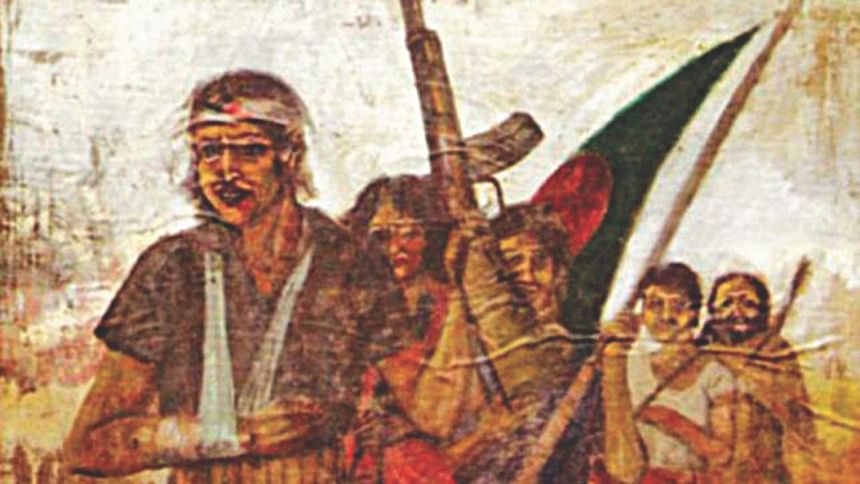
Three things -- the Father of the Nation Bangabandhu Sheikh Mujibur Rahman, the glorious Liberation War of 1971 and the world of art -- play significant roles in the conscience and lifestyle of internationally famous Bangladeshi artist Shahabuddin Ahmed. A Freedom Fighter, he exhibited paintings in the war camp in 1971. His canvas has been full of motion and movement, vigour and liveliness while his bold brush has depicted the epic of our glorious Liberation War in a magnanimous way.
Shahabuddin hoisted the Bangladeshi flag in erstwhile East Pakistan radio at 11:30 am on December 16, when the Pakistan army was yet to surrender. But, he knew what was going to happen. “This was the indomitable spirit and I kept that up. I take pride in that,” says Shahabuddin Ahmed. “I fought a nine-month battle to free my motherland. This is the glorious part of my life. Freedom is becoming more priceless as days go by. The birth of Bangladesh would not be possible without the birth of Bangabandhu Sheikh Mujibur Rahman. Pakistani army acted like fools. They thought their conspiracies and atrocities would bear fruit. But the freedom-loving Bangalees proved our victory over them,” said Shahabuddin Ahmed, whose famous series includes ‘Freedom’, ‘Platoon’, ‘Le Victoire’, ‘Arreter Le Genocide’ and more.
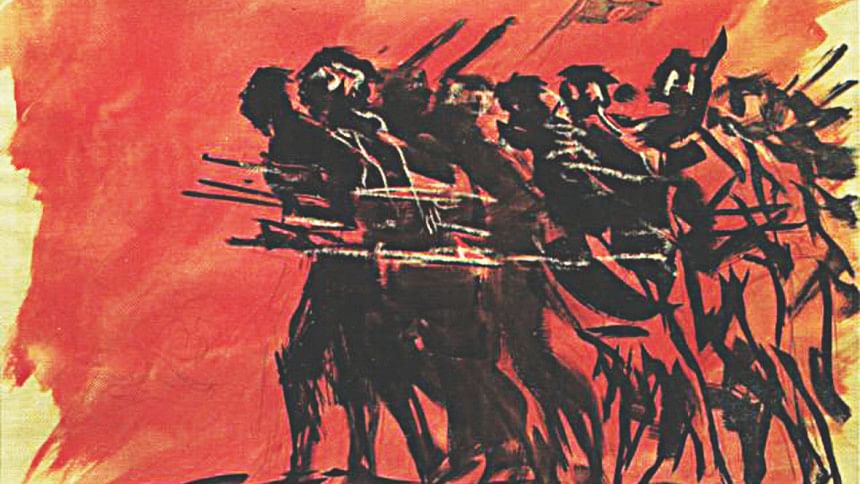
The contributions of our women artists to the Liberation War and the post-independent Bangladesh are no less important than their male counterparts. Artist Hashem Khan regards the life of eminent sculptor and Freedom Fighter Ferdausi Priyabhashini as a great piece of art. Ferdousi Priyabhashini was the first one to publicly announce herself as a Birangona, a term coined by Bangabandhu Sheikh Mujibur Rahman for women who had survived sexual violence during the war. As an honest and courageous personality, she struggled through her entire life for the justice of anti-liberation forces. Thus she established the status of Birangonas as Freedom Fighters in our society, and we published the testimony of her persecution. She held war children close to her heart and proudly declared that she was their mother. As a sculptor she took her artwork to new heights. She transformed many discarded raw materials into art. Renowned sculptor Lalarukh Selim and prominent painters Farida Zaman, Nazlee Laila Mansur and Rokeya Sultana depicted artworks on the theme of Bangladesh’s Liberation War, beautiful landscapes, political aspects and people’s struggles in their artworks.
Eminent artists Rashid Choudhury, Samarjit Roy Choudhury, Monirul Islam, Kalidas Karmakar, Nisar Hossain, Shahid Kabir, Jamal Ahmed, Sheikh Afzal Hossain, Ahmed Shamsuddoha and others too portrayed paintings and prints on Bangladesh’s Liberation War. Monirul Islam portrayed a famous print titled “The Birth of Bangladesh” in Madrid, Spain. Politically conscious artist Nisar Hossain depicted a number of artworks on Liberation War.
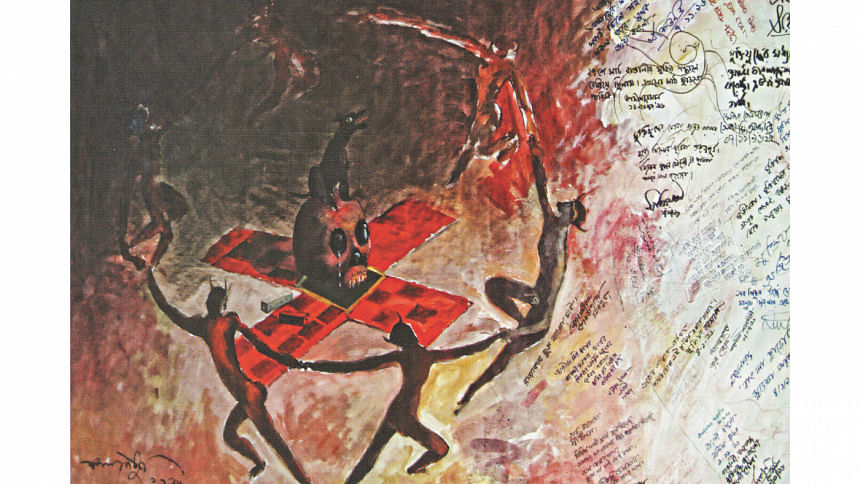
Artist Biren Shome’s book titled ‘Bangladeshi artists’ contribution to the Liberation War of 1971’ is a bit of a rarity. What truly sets it apart is the rich trove it provides of the imagery associated with the war, as seen through the eyes of the nascent state’s mostly young, ragtag band of artists, expressed in a variety of mediums. Many of the works, especially the posters, will be familiar to readers. For example, the famous print proclaiming the unity of all religions among the Bengali Freedom Fighters that has adorned many a university student’s dorm wall, we now know, was the work of artist Debdas Chakraborty. Similarly, it was Pranesh Mandal who put a name to the iconic image of the woman freedom fighter above a proclamation that Bengal’s mothers and daughters were all Freedom Fighters.
Sculpture is considered one of the most important and lasting genres of art. After the Liberation War, sculptures in Bangladesh mainly focused on the theme of the independence movement. Many significant sculptures were built in the mid ’70s and early ’80s. Abdur Razzaque is regarded as one of the greatest sculptors of the country, who was the first artist to take up sculpture in independent Bangladesh. His ‘Jagroto Chowrongi’ is considered one of the best sculptures in Bangladesh, considering both form and theme. Located in Joydebpur, Gazipur, and built in 1973, it is the first post-Liberation War sculpture. It depicts a Freedom Fighter with a grenade in his right hand and a rifle in his left hand. The sculpture is an 18 feet high concrete piece on a 24 feet pedestal.
Syed Abdullah Khalid’s ‘Aparajeyo Bangla’, located on the Dhaka University campus, has become an iconic sculpture in the post-independent Bangladesh. The sculpture is a reflection of the Bangalees’ indomitable yearning for freedom. The project was launched in 1973 when this artist was a young teacher at the Department of Fine Arts, Chittagong University. Hasina Ahmed, Syed Hamid Moksood and Badrul Alam Benu, who were very close to Khalid, modelled for ‘Aparajeyo Bangla’. On August 15, 1975, the work suddenly came to a halt because of the heinous murder of Bangabandhu Sheikh Mujibur Rahman. Political instability and the arrest of the then Vice-chancellor of Dhaka University, Abdul Matin Chowdhury, also disrupted the work.
The project remained incomplete till the end of 1978. Some extremist groups tried to demolish the sculpture in 1977. However, the brave students of Dhaka University fiercely guarded the work. After a long hiatus, the work began once more in the beginning of 1979 -- with a new vision. At last the project was finished on December 16, 1979. The sculpture was inaugurated by the wounded Freedom Fighters.
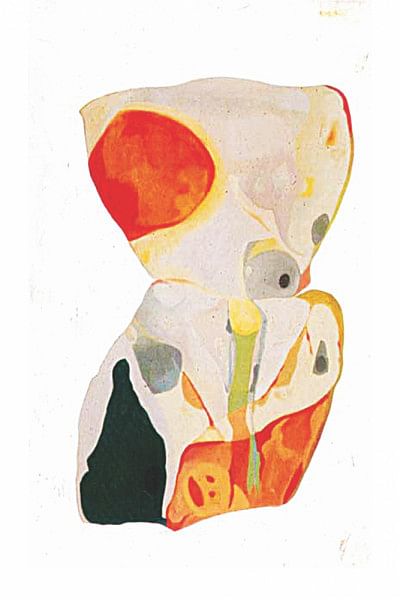
Hamiduzzaman Khan, a renowned sculptor and painter, created many sculptures on the theme of Liberation War. One can detect Khan’s endeavour to mix architectural or geometrical shapes with local materials in his creations. His prime concerns revolve around form and theme. After 1971, the sculptor tried to understand the significance of sculptures and took interest in this form of art. During that time, he concentrated on the Liberation War as a theme, and the subject was a great source of inspiration for Bangladeshi artists. One of his most moving creations is ‘Shongshoptok’. It stands 28 feet high, including the base. It is constructed of steel armature and brass steel. The work has been placed in front of the Central Library, Jahangirnagar University. It depicts a Freedom Fighter with a hand missing, yet ready to fight against the Pakistani forces. The fighter carries a rifle in his hand. It is a sign of the Freedom Fighters’ valour and their dedication to free the country. Hamiduzzaman Khan’s other iconic sculptures on the theme include ‘Joy Bangla’, placed at the Patuakhali University of Science and Technology; ‘Freedom’, a 120-feet long mural located at the National University and ‘Remembrance ’71’, placed at the Open University campus premises in Gazipur.
‘Shoparjito Shadhinata’ by Shamim Sikder also evokes the memory of the Liberation War. Located at TSC in Dhaka University it was built in the early 1990 and is a rather complex structure demonstrating many facets of 1971.
The Museum of Independence in Dhaka depicts the struggle for independence of Bangladesh showcasing the rich history of the nation. It is the first and only underground museum in the country. The museum is part of a 67-acre complex at Suhrawardy Udyan, the site from where Bangabandhu Sheikh Mujibur Rahman gave his historic 7th March Speech declaring the struggle for independence, and where the Pakistani forces surrendered after the War of Liberation on 16 December 1971. The entrance of the museum is adorned with a fascinating terracotta mural that delineates country’s chronological history, heritage and glorious movements shedding light on the 1947 partition and 1952 Language Movement to the Victory of 1971 Liberation War. A five-member artist group named ‘The Artist’ led the execution of the gigantic terracotta mural, which is regarded as the largest one in Asia. Renowned artists and sculptors – Professor Mohammad Eunus, Shyamal Chowdhury, Shishir Bhattacharjee, Iftikhar Uddin Ahmed and Mukul Muksuddin Rana – competed for portraying the work. About 200 artists and sculptors assisted the five artists to complete it.
Another important memorial complex on Liberation War is the ‘Mujibnagar Smriti Soudha’, which has been built at the site of the oath taking ceremony in Mujibnagar, Meherpur. The memorial, covering an area of 20.10 acres, is the symbol of our Liberation War and the sacrifice of the Bangalees. This monument was erected on twenty-three triangular shaped concreted pillars, and appears to be a symbol of the rising sun in its design planned by architect Tanveer Naquib.
Renowned sculptor Mojibur Rahman led a 15-member artist team to depict a number of sculptures highlighting various events and happenings of the wartime Bangladesh. Nearly half a century later, sculptures highlighting key events of Bangladesh’s Liberation War are being installed there to inform people about the nation’s struggle for freedom. The multi-million taka projects include infrastructural development, Liberation War-based memorial map and a museum.
The map also depicts the Pakistani occupation force’s massacre at Rajarbagh Police Lines and Jagannath Hall in Dhaka University, Pahartali in Chattogram and Rajshahi, the destruction of the Jatiya Press Club, attack on Secretariat and Pilkhana, the killing of intellectuals and the Rayer Bazar mass killing ground.
Forty sculptures have been installed around the map showing the courageous leadership and roles of the leaders during the Liberation War. The museum contains images of four national leaders, the then army chief, deputy chief, Bir Uttam and Bir Protik Taramon Bibi and Setara Begum. There are 29 bronze busts and oil paintings of 30 important national leaders.
The outer side of the map has been decorated with a mural depicting Bangabandhu’s historic March 7 speech, the dark night of March 25, rape and torture of women by Pakistani occupation forces, and torching of Freedom Fighters’ houses.
Other historical events, such as the oath-taking of the Mujibnagar Government and the guard of honour, clandestine meeting of sector commanders in Sylhet’s Teliapara, and surrender of Pakistani forces, have been depicted with life-size statues.
Bharat-Bangladesh Maitree Udyan (India-Bangladesh Friendship Park) in Chottakhola, Tripura, was one of the base camps of Bangladeshi Freedom Fighters from where they launched a guerrilla warfare against the Pakistani army in Chattogram, Cumilla and greater Noakhali.
Located near the international border, the Maitree Udyan is a park built at Chottakhola as a tribute to the Bangladeshi Freedom Fighters and Indian soldiers, who sacrificed their lives during the Liberation War. A war museum, hillocks, verdant valleys, lakes, plants, sculptures, graveyards of Bangladeshi Freedom Fighters with various other elements, this is not just a park but much more than that.
The memorial park was a long cherished demand of Tripura people as they were actively involved in the Liberation War. They provided all-out support to Freedom Fighters and sheltered around 1.6 million people, a number exceeding the then population of the state.
Chottakhola, 130 kilometres from Tripura’s capital Agartala, had functioned as one of the 11 warfront-camps in Tripura in 1971. The then Bangladesh’s Foreign Minister Dipu Moni laid the foundation stone of the park on 11 November 2010.
The beautiful location comprises seven hillocks partly separated by a natural lake over 20 hectares of land. It saw intense activities during the Liberation War and still bears its memorabilia in the form of remnants of a number of bunkers and trenches built on it in 1971.
The park includes an elaborate garden, museum, children’s park and helipad, and is connected to the neighbouring handicraft producing village with another wooden bridge. Accommodations with modern facilities, with village-home decoration, are situated across the road running by the side of the site. A chestnut garden flanks the other side of the park.
Former Tripura Chief Minister Manik Sarkar inaugurated the memorial and park in the presence of Indian and Bangladeshi artists, intellectuals and freedom fighters on December 16, the Victory Day of Bangladesh.
Statues of the then Prime Minister Indira Gandhi and the founder of Bangladesh, Bangabandhu Sheikh Mujibur Rahman, have also been erected in the park.
Renowned artists from Tripura and Bangladesh are part of the project with their creations -- from statues to paintings -- that added to the memorial’s attraction. Bangladeshi artists and sculptors Hashem Khan, Mahmudul Hasan Shohag, Shyamal Chowdhury and Tejosh Halder Josh depicted sculptures for the park.
The memorial park would help successive generations of Bangladesh learn the history of their hard won independence and how the two friendly neighbours joined forces to bring about the country’s liberation.
Artist Professor Nisar Hossain, also Dean of the Faculty of Fine Art, University of Dhaka, however, thinks that artists have not depicted enough work on the Liberation War. He suggests that the new generation of artists should depict more artworks on the theme so that the forthcoming generations are inspired to create art on the Liberation War.
Zahangir Alom is a staff reporter, Arts & Entertainment, The Daily Star.
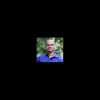
 For all latest news, follow The Daily Star's Google News channel.
For all latest news, follow The Daily Star's Google News channel. 


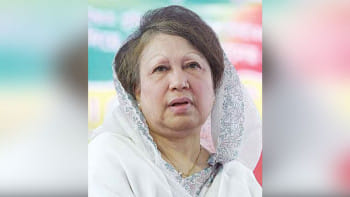
Comments